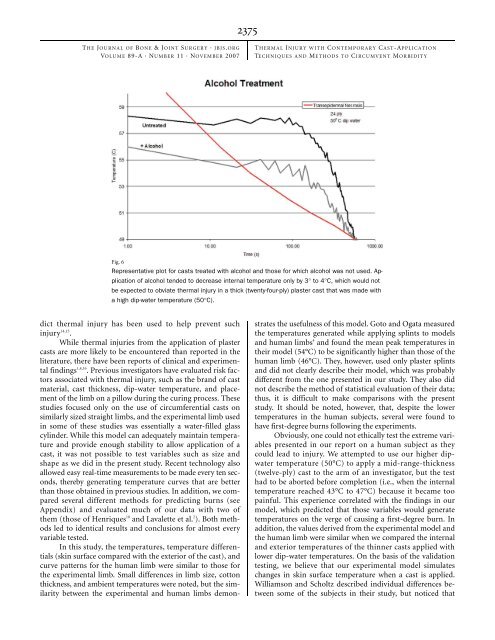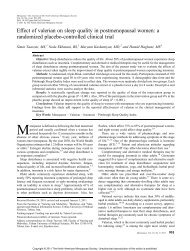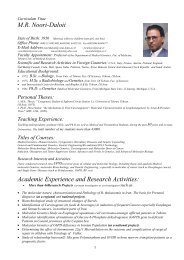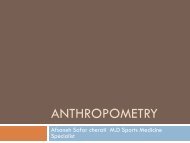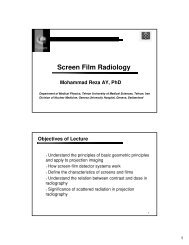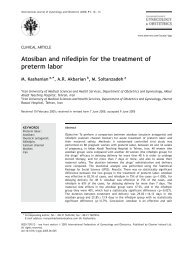Thermal Injury with Contemporary Cast-Application Techniques and ...
Thermal Injury with Contemporary Cast-Application Techniques and ...
Thermal Injury with Contemporary Cast-Application Techniques and ...
You also want an ePaper? Increase the reach of your titles
YUMPU automatically turns print PDFs into web optimized ePapers that Google loves.
THE JOURNAL OF BONE & JOINT SURGERY · JBJS.ORG<br />
VOLUME 89-A · NUMBER 11 · NOVEMBER 2007<br />
Fig. 6<br />
dict thermal injury has been used to help prevent such<br />
injury 14,15 .<br />
While thermal injuries from the application of plaster<br />
casts are more likely to be encountered than reported in the<br />
literature, there have been reports of clinical <strong>and</strong> experimental<br />
findings 1,4,16 . Previous investigators have evaluated risk factors<br />
associated <strong>with</strong> thermal injury, such as the br<strong>and</strong> of cast<br />
material, cast thickness, dip-water temperature, <strong>and</strong> placement<br />
of the limb on a pillow during the curing process. These<br />
studies focused only on the use of circumferential casts on<br />
similarly sized straight limbs, <strong>and</strong> the experimental limb used<br />
in some of these studies was essentially a water-filled glass<br />
cylinder. While this model can adequately maintain temperature<br />
<strong>and</strong> provide enough stability to allow application of a<br />
cast, it was not possible to test variables such as size <strong>and</strong><br />
shape as we did in the present study. Recent technology also<br />
allowed easy real-time measurements to be made every ten seconds,<br />
thereby generating temperature curves that are better<br />
than those obtained in previous studies. In addition, we compared<br />
several different methods for predicting burns (see<br />
Appendix) <strong>and</strong> evaluated much of our data <strong>with</strong> two of<br />
them (those of Henriques 10 <strong>and</strong> Lavalette et al. 2 ). Both methods<br />
led to identical results <strong>and</strong> conclusions for almost every<br />
variable tested.<br />
In this study, the temperatures, temperature differentials<br />
(skin surface compared <strong>with</strong> the exterior of the cast), <strong>and</strong><br />
curve patterns for the human limb were similar to those for<br />
the experimental limb. Small differences in limb size, cotton<br />
thickness, <strong>and</strong> ambient temperatures were noted, but the similarity<br />
between the experimental <strong>and</strong> human limbs demon-<br />
2375<br />
T HERMAL INJURY WITH CONTEMPORARY CAST-APPLICATION<br />
TECHNIQUES AND METHODS TO CIRCUMVENT MORBIDITY<br />
Representative plot for casts treated <strong>with</strong> alcohol <strong>and</strong> those for which alcohol was not used. Ap-<br />
plication of alcohol tended to decrease internal temperature only by 3° to 4°C, which would not<br />
be expected to obviate thermal injury in a thick (twenty-four-ply) plaster cast that was made <strong>with</strong><br />
a high dip-water temperature (50°C).<br />
strates the usefulness of this model. Goto <strong>and</strong> Ogata measured<br />
the temperatures generated while applying splints to models<br />
<strong>and</strong> human limbs 4 <strong>and</strong> found the mean peak temperatures in<br />
their model (54°C) to be significantly higher than those of the<br />
human limb (46°C). They, however, used only plaster splints<br />
<strong>and</strong> did not clearly describe their model, which was probably<br />
different from the one presented in our study. They also did<br />
not describe the method of statistical evaluation of their data;<br />
thus, it is difficult to make comparisons <strong>with</strong> the present<br />
study. It should be noted, however, that, despite the lower<br />
temperatures in the human subjects, several were found to<br />
have first-degree burns following the experiments.<br />
Obviously, one could not ethically test the extreme variables<br />
presented in our report on a human subject as they<br />
could lead to injury. We attempted to use our higher dipwater<br />
temperature (50°C) to apply a mid-range-thickness<br />
(twelve-ply) cast to the arm of an investigator, but the test<br />
had to be aborted before completion (i.e., when the internal<br />
temperature reached 43°C to 47°C) because it became too<br />
painful. This experience correlated <strong>with</strong> the findings in our<br />
model, which predicted that those variables would generate<br />
temperatures on the verge of causing a first-degree burn. In<br />
addition, the values derived from the experimental model <strong>and</strong><br />
the human limb were similar when we compared the internal<br />
<strong>and</strong> exterior temperatures of the thinner casts applied <strong>with</strong><br />
lower dip-water temperatures. On the basis of the validation<br />
testing, we believe that our experimental model simulates<br />
changes in skin surface temperature when a cast is applied.<br />
Williamson <strong>and</strong> Scholtz described individual differences between<br />
some of the subjects in their study, but noticed that


